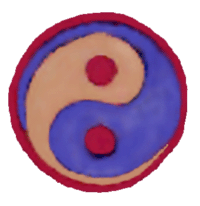
The Notitia Dignitatum is a directory of the civil and military administration of the Roman Empire, and was compiled between 395 and 430 CE. Alongside the textual lists are the emblems and insignia used by the various official departments.
The earliest known surviving edition dates to around 1436 (now at the Bodleian Library, Oxford), which is a copy of a probably 10th century manuscript (the Codex Spirensis). Three other copies were made from the Codex Spirensis before it was lost.
I first became aware of this important document in 2003, from a webpage by Dr Giovanni Monastra who works in Rome, Italy, and has studied the deep meanings of symbols for many years. In his article, published in 1996, he called attention to the fact that among the hundreds of emblems there are several that appear to accurately depict the Taiji Tu ("supreme ultimate symbol", or yin/yang symbol) in various forms. The three mentioned below all belong to the insignia of the magistri peditum, of the Western Empire.
Most striking is the picture associated with shields of the Armigeri defensores seniores, which not only shows the spiral form of the Taiji Tu, but includes their tell-tale "eyes" (see Taiji Tu for diagrams showing the mathematical basis of this design).
My curiosity aroused, I scoured the Web and found an excellent website by Luke Ueda-Sarson devoted to Late Roman Sheild Patterns, which shows colour illustrations of the Bodleian manuscript. The following is a crude imitation of the Armigeri shield, but you can see the real thing at Luke's site.

This provides evidence that the Taiji Tu is, as many researchers have suspected (self included), much older than the earliest surviving Chinese depictions (Sung dynasty, 960 - 1279 CE), which is why the Notitia Dignitatum makes such an important contribution to the study of this fundamental icon. This Roman version is likely to have been inspired by motifs in Celtic art, where such patterns of swirling lines were highly fashionable, and designs involving not only two or three but numerous spiralling elements were abundant.
The emblem of the Mauri Osismiaci is similar to the Armigeri but rotated 180 degrees and without the extended arms of the spiral form. You can see it at Luke's site.
The emblem of the Thebaei (see it at Luke's site) is particularly intriguing as it is powerfully reminiscent of a Sung dynasty version of the Taiji Tu (a version little known in the West but hugely influential in China), based on a pair of three-line figures, one representing fire, and the other water.

The Notitia certainly is an enigma.
An article published in 1983 "Inconsistency and Lassitude: The Shield Emblems of the Notitia Dignitatum" (The Journal of Roman Studies; Volume LXXIII, pp 132-42) cautions against accepting the Notitia at face value. In it Robert Grigg provides a statistical analysis of the shield emblems, with key criteria including the overall diversity of images, and the expectation of a shared visual identity between related military units. On both key issues he finds the Notitia's artist wanting. Crucially, he concludes that the artist employed his imagination when actual information on the images in use were lacking or unclear. Grigg is nevertheless comfortable with the assumption that the text and emblems are contemporary with each other, which offers us a milestone in the development of these remarkable images.
It is possible to argue that some sort of gradual diffusion took the spiralling image from the Roman insignia of the fourth or fifth centuries CE to the Chinese philosophers some thousand years later (who are generally credited with the first oriental depiction of the classic yin/yang symbol). However, it is also possible that the Taiji Tu evolved as an independent tradition in China. This latter conjecture is strengthened by the observation that the Taiji Tu can apparently be produced directly from the Early Heaven Ba Gua.
As befits a symbol that claims universal application, examples begin to crop up wherever one looks. For an intriguing instance of an even earlier Taiji Tu (circa 400 years BCE), see my Wrestling with Yin & Yang.
I would like to extend my particular gratitude to Bob Jamaica for his constructive feedback on this page, and to Ingo Maier for supporting my efforts to gain an accurate appreciation of the Notitia (any inaccuracies in this appraisal are, naturally, mine not theirs).
© Ken Taylor 2004-2010